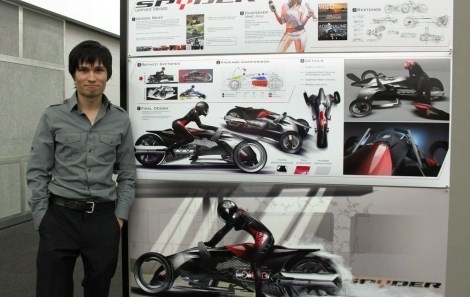NASF Bright Design Challenge Selects Scholarship Winners
Leonard Takata, Yuyol Lee, Minwoo Song and Andrew Bianchi win scholarships
#nasf

Featured Content
NASF just wrapped up the 2012 Bright Design Challenge scholarship competition with some very talented design students from the Detroit-based College for Creative Studies. The event is part of the Surface Technology Initiative, which the association launched last year to spotlight the vital role of surface finishing in both the value chain and society.
The students competed in early May, and their designs incorporated some very creative surface coatings concepts for CAN-AM/BRP’s three-wheel Spyder, which is considered a “paradigm-shifting vehicle that makes a true statement.”
Congratulations to our 2012 winners:
- First Place – Leonard Takata
- Second Place – Yuyol Lee
- Third Place – Minwoo Song
- Honorable Mention – Andrew Bianchi
The designs can be seen on the new NASF Bright Design website at nasfbrightdesign.com.
Thank you to our judges: Robert Walker, Chrysler; Mark Jarvis, Visteon; Brandon Faurote, Chrysler; Matt Tandrup, CAN-AM/BRP; Ted Natorski, Enthone/Cookson Performance Products; Tony Revier, Uyemura; and Greg Miller, Ford Motor Co. and College for Creative Studies instructor.
We also would like to thank our sponsors for their support:
- Gold Sponsors: Enthone, MacDermid
- Silver Sponsors: Coventya, Uyemura
- Sponsors: Ohio Association of Metal Finishers, and Metal Finishing Associations of Southern California, Northern California and San Diego
For more information or to sponsor these or other national and chapter outreach activities, contact Phil Assante at NASF headquarters at passante@nasf.org or 703-887-7235.
RELATED CONTENT
-
Plating Q&A: Can you color stainless steel?
Our expert, Art Kushner, says yes, you can color stainless steel, but it is not a process that is typically performed in a plating shop. Read more about his answer.
-
Masking for Surface Finishing
Masking is employed in most any metal finishing operation where only a specifically defined area of the surface of a part must be exposed to a process. Conversely, masking may be employed on a surface where treatment is either not required or must be avoided. This article covers the many aspects of masking for metal finishing, including applications, methods and the various types of masking employed.
-
Copper Plating on Aluminum and Aluminum Alloys
How can I plate copper on aluminum?


















